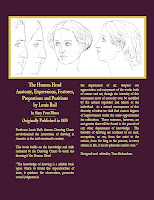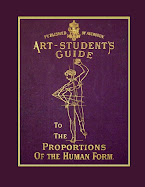The Human Head: A Correct Delineation of the Anatomy, Expressions, Features, Proportions and Positions of the Head and Face is now available as a printed book at Amazon.com
is now available as a printed book at Amazon.com
Learn more about it at this post, or at Figure-Drawings.com. View a preview at Google Books.
He argues for the study of anatomy in order to improve the quality of American Art. "While the study of anatomy is so much neglected in this country, the productions of American art must be superficial and unsatisfactory. The thorough student of art finds himself rapidly acquiring knowledge of human nature. He beholds, as it were, a veil drop from the faces of his fellow-men, catches their changing emotions; understands the lights and shades of character, and reads the inner life. To assist you somewhat in this, I have given you some verbal delineations of character which I desire you to consider as simple suggestions, and by the aid of which, you will, I trust, pursue the study of the human organization and character in an ample form. Once commence to explore and analyze this department in nature, and you will find it as interesting as it is inexhaustible."
The book was published at a time when there was a movement among educators to include the study of drawing in school curriculums both to improve the quality of thinking in students, but also to provide skilled workers for the new industrialism. Here is Louis Bail lamenting the lack of skill among American workers (sounds familiar in this day when high tech entrepreneurs complain about the need for more visas for workers from other countries) "Why is it that a majority of our apprentices are of foreign parentage? Why is it that American boys are growing too proud to "learn a trade"? Is not the cause found in the fact that our whole system of education has quite ignored the industrial life? The only legitimate result of our educational system will be the production of lawyers and doctors, or, at the least, clerks and school teachers. In consequence of this defect, children receive the impression that education has no bearing upon mechanics; that a trade is only manual drudgery. The result is, that our boys select the most effeminate employments in preference to manly mechanical work."
Bail also published a series of drawing charts which used a step by step approach to learning to draw. They became widely used in schools. This book about drawing the head was the next step for him. This is an argument for the use of the drawing charts explaining what was lacking n contemporary education: "The great obstacles to the successful teaching of Drawing in Common Schools,
have been:
1st. The lack of artistic culture and practical skill on the part of teachers.
2d. The lack of time sufficient to give pupils that individual intruction made necessary by the instructions heretofore in use.
3d. The mistaken notion that Drawing either as a science or as an art, can be acquired by transferring pictures from one piece of paper to another, without a systematic training of the hand and eye.
4th. The delaying of the stndy and practice of the art until the natural taste for the exercise has been outgrown, and the pupil's time has become too valuable to be pleasurably devoted to the training in elementary principles, necessary to ensure certain and reliable progress in the art."
A list of the plates in the book:
The Human Skull
The Human Skull from the front.
The Muscles of the Human Head
The Muscles of the Human Head from the front.
How to Draw the Mouth.
How to Draw Eyes
How to Draw Eyes from the front.
How to Draw Ears.
Facial Angles
The Outline and Proportions of the Human Head
The Outline and Proportions of the Human Head from the front.
The Head Looking Down.
The Head Looking Up.
Three-Quarters View of the Head - 2 plates.
Three-Quarters View of the Head looking down - 2 plates.
Three-Quarters View of the Head looking up - 3 plates.
Sample Drawings of Heads Illustrating the Principles of Drawing - 17 plates.
How to Draw a Caucasian.
How to Draw a African.
How to Draw Old Age - 2 plates.
How to Draw Infancy - 2 plates.
How to Draw Sobriety.
How to Draw Laughter - 3 plates.
How to Draw Discontent.
How to Draw Severity.
How to Draw Fright.
How to Draw Anxious Watchfulness.
How to Draw Bodily Fear.
How to Draw Weeping.
How to Draw Terror.
How to Draw Prayer - 2 plates.
How to Draw Innocence.
How to Draw a Misanthrope.
How to Draw Surprise.
How to Draw Great Pain.
How to Draw Rage.
An original copy of The Human Head; a Correct Delineation of the Anatomy, Expressions, Features, Proportions and Positions of the Head and Face




















No comments:
Post a Comment